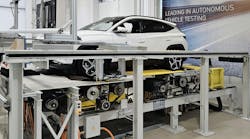Issues of reliability and road safety are key challenges for future mobility solutions, especially automated and autonomous vehicles that must ensure the functionality of advanced driver-assistance (ADAS) and autonomous-driving (AD) systems.
To address long-term vehicle safety and performance, vehicle manufacturers require certification. A vehicle-in-the-loop (VIL) test helps accomplish that goal by validating the correct operation of all ADAS/AD functions at the end-of-line to ensure conformity of production.
To serve these requirements, Dürr and Rohde & Schwarz started a joint project using Dürr's x-road curve multifunction roll test stand, Rohde & Schwarz’s RadEsT radar target simulator, and the CARLA open-source simulation platform to create a virtual environment specifically for the camera and radar sensors installed in the test vehicle.
The combined functionality allows for the OTA simulation of different inspection scenarios without touching the vehicle. It tests for critical situations such as unintended lane departures and other vehicles braking suddenly or switching lanes directly in front of the test vehicle.
Benefits of the Platform's Components
The 4WD x-road curve platform enables unrestricted driving with steering movements so that the test vehicle can perform cornering maneuvers. Lasers measure front wheels’ position and steering angle, swiveling front double roller units to automatically adjust for any angular difference to the driving direction. The vehicle remains centered on the test stand even at high speeds, regardless of the steering wheel’s position, and without the need to secure the vehicle further.
Rohde & Schwarz’ RadEsT radar target simulator is resilient to external factors, ensuring consistent performance in production and workshop environments, providing precise and repeatable measurements in real-world conditions.
The CARLA open-source tool maximizes flexibility, offering cost-saving opportunities and the potential for scenario selection. A recent upgrade of the CARLA simulator to Unreal Engine 5 should enhance modeling, simulation realism, and performance, particularly for over-the-air camera simulation.
Related links:

